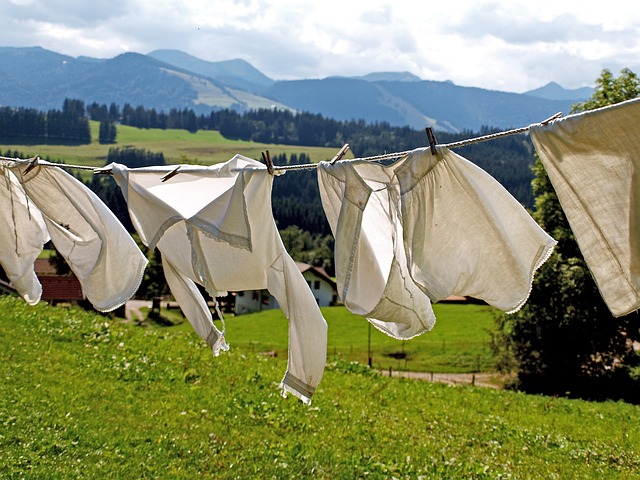Looking for eco-friendly laundry tips? You’ve come to the right place! In this blog post, we will discuss some of the best ways to clean your clothes in an environmentally friendly way. There are many different ways to do this, and we will explore a few of them in detail. So whether you’re looking for sustainable laundry detergent or want to know how to wash clothes without water, we have you covered!

Use Cold Water When You Can
Have you ever started your washing machine, only to realize afterward that you forgot to change the settings? On my machine, the default is a hot water cycle.
You can save a lot of energy and money by doing something as simple as switching your laundry settings from hot to cold water. As much as 90 percent of the total energy used in one cycle is just to heat the water, so you’ll be saving quite a bit by making this small change.
Of course, you may not be able to wash in cold water all of the time: Certain fabrics, such as spandex and nylon, recommend washing in warm water (when in doubt, follow instructions on the label). If someone in your home is sick, washing their clothes in hot water can kill germs and bacteria. Just remember to wash their clothing separately from everyone else’s, and run an empty cycle with disinfectant after you’re done.
Choose an Eco-Friendly Detergent
Many commercial detergents, on the other hand, contain harsh chemicals. Dyes, chlorine, phosphate, and strong enzymes (such as cellulase) are all frequent components in laundry detergent; they not only pollute the environment but can also irritate sensitive skin and damage your clothes.
The next time you buy laundry detergent, consider an environmentally friendlier option. It will clean your clothes just as well (including delicates), without any extra chemicals that can harm the environment.
Swap plastic bottles for glass.
Choose cleaners in reusable containers to break the habit of continuously purchasing plastic bottles. Many glass spray bottles now include a silicone cover to prevent falls or tumbles, allowing you to buy all sorts of cleaning solutions. Not only is this better for the environment, but it will also save you money in the long run. You only have to buy the glass container once and refills are usually cheaper.

Air-Dry Your Clothes
Summertime is a good time to air-dry clothing and linens rather than using the dryer. Retractable clotheslines are surprisingly cost-effective, and they may be positioned between trees, on your deck, or even on a small balcony. Do you have a lack of outside area? A drying rack may be used to dry clothes indoors, and it’s a must-have for delicate articles.
… Or Invest in Dryer Balls
You can use dryer balls to cut your dryer’s runtime. These wool balls absorb moisture from clothes, so you can put the dryer on a lower heat setting. This also significantly reduces drying time overall not too shabby, right? As a bonus, they soften clothes and reduce wrinkles.
Only Run Full Loads
A full-size traditional washing machine uses 20 gallons of water per load on average, while an energy star certified washer uses only 14. Even if you have the latter, that’s still quite a bit of water for just a few items of clothing.
Although there will be laundering needed before you have a full load, as a general rule of thumb, try to only run the washing machine when it’s full. Yes, less laundry overall!
For those situations when you only need to wash one or two things, there are a variety of gadgets on the market that make hand-washing clothes considerably easier, from clothes washing wands to portable wash bags.
Wash in Cold Water
Laundry detergents are designed to be used in cold water, which is a fantastic technique to save money on your energy bill. It’s thought that 75 to 90 percent of all the power consumed by your washer goes toward heating the water.
If we only washed our clothes in cold water, it would save the same amount of energy every year as 3.7 million American homes use!
Wash Clothes When They’re Actually Dirty
Washing regularly worn clothes minimizes the amount of laundry and work required, so you might want to think about how often you clean certain things. According to the American Cleaning Institute, jeans and pajamas may be worn three or four times before being washed.
If you aren’t sure whether an item is clean or not, check for any smells or stains. Oftentimes, all that it needs is a quick steam or stain removal to keep the clothing fresh between wearing and washing.

Skip the Chlorine Bleach
Although Bleach is known for removing tough stains, it can be harsh on the environment. There are several alternative methods you should consider using to treat clothing stains.
There are a lot of laundry Whitening products out there that can do the job, Or you might already have something in your house that can work just as well. For instance, did you know lemon juice has natural bleaching power? Just add a cup to a load of white clothing next time you wash them to help keep them bright and reduce dingy underarm spots.
As I mentioned earlier, you can also air out stained items in direct sunlight to let the sun’s UV rays work their natural bleaching magic.

